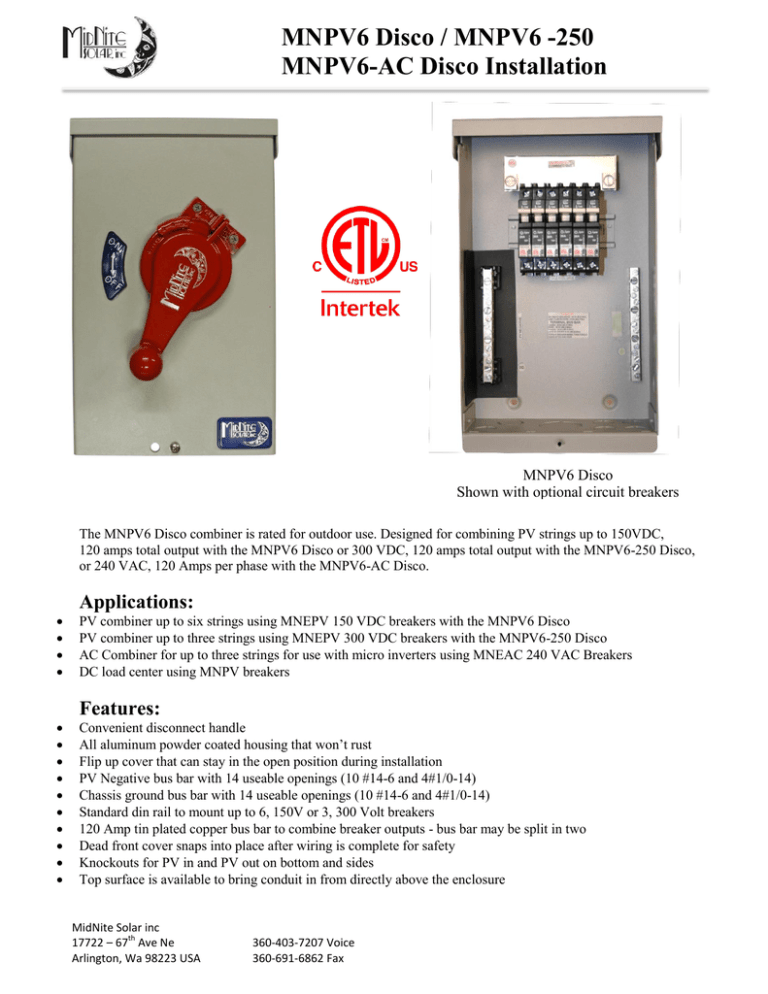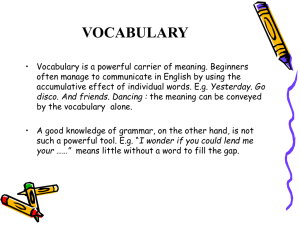MNPV6 Disco Manual
advertisement

MNPV6 Disco / MNPV6 -250 MNPV6-AC Disco Installation Instructions MNPV6 Disco Shown with optional circuit breakers The MNPV6 Disco combiner is rated for outdoor use. Designed for combining PV strings up to 150VDC, 120 amps total output with the MNPV6 Disco or 300 VDC, 120 amps total output with the MNPV6-250 Disco, or 240 VAC, 120 Amps per phase with the MNPV6-AC Disco. Applications: PV combiner up to six strings using MNEPV 150 VDC breakers with the MNPV6 Disco PV combiner up to three strings using MNEPV 300 VDC breakers with the MNPV6-250 Disco AC Combiner for up to three strings for use with micro inverters using MNEAC 240 VAC Breakers DC load center using MNPV breakers Features: Convenient disconnect handle All aluminum powder coated housing that won’t rust Flip up cover that can stay in the open position during installation PV Negative bus bar with 14 useable openings (10 #14-6 and 4#1/0-14) Chassis ground bus bar with 14 useable openings (10 #14-6 and 4#1/0-14) Standard din rail to mount up to 6, 150V or 3, 300 Volt breakers 120 Amp tin plated copper bus bar to combine breaker outputs - bus bar may be split in two Dead front cover snaps into place after wiring is complete for safety Knockouts for PV in and PV out on bottom and sides Top surface is available to bring conduit in from directly above the enclosure MidNite Solar inc th 17722 – 67 Ave Ne Arlington, Wa 98223 USA 360-403-7207 Voice 360-691-6862 Fax MNPV6 Disco / -250 / AC Disco Installation Instructions Cont. IMPORTANT SAFETY INSTRUCTIONS SAVE THESE INSTRUCTIONS - These instructions contain important safety and operating instructions for the MidNite Solar MNPV6 Disco and MNPV6-250 Disco solar combiner boxes. If you do not fully understand any of the concepts, terminology, or hazards outlined in these instructions, please refer installation to a qualified dealer, electrician or installer. These instructions are not meant to be a complete explanation of a renewable energy system. GENERAL PRECAUTIONS WORKING WITH OR IN THE VICINITY OF A LEAD ACID BATTERY, SEALED OR VENTED IS DANGEROUS. VENTED BATTERIES GENERATE EXPLOSIVE GASES DURING NORMAL OPERATION. FOR THIS REASON, IT IS VERY IMPORTANT THAT BEFORE SERVICING EQUIPMENT IN THE VICINITY OF LEAD-ACID BATTERIES YOU REVIEW AND FOLLOW THESE INSTRUCTIONS CAREFULLY. If service or repair should become necessary, contact MidNite Solar Inc. Improper servicing may result in a risk of shock, fire or explosion. To reduce these risks, disconnect all wiring before attempting any maintenance or cleaning. Turning off the inverter will not reduce these risks. Solar modules produce power when exposed to light. When it is not possible to disconnect the power coming from the Photovoltaics by an external means such as a combiner, cover the modules with an opaque material before servicing any connected equipment. Never attempt to charge a frozen battery. When it is necessary to remove a battery, make sure that the battery bank disconnect breaker is in the off position and that the PV breakers, grid breakers and any other sources of power to the inverter are in the off position. Then remove the negative terminal from the battery first. To reduce risk of battery explosion follow these instructions and those published by the battery manufacturer as well as the manufacturer of any additional equipment used in the vicinity of the batteries. Before installing the battery enclosure, read all instructions and cautionary markings in or on any connected electrical equipment. Avoid producing sparks in the vicinity of the batteries when using vented batteries. Provide ventilation to clear the area of explosive gases. Sealed AGM and Gel batteries do not under normal conditions create explosive gases. Be especially cautious when using metal tools. Dropping a metal tool onto batteries can short circuit them. The resulting spark can lead to personal injury or damage to the equipment. Provide ventilation to outdoors from the battery compartment when installing vented batteries such as golf cart T-105 batteries. The addition of a spill tray is also a good idea. Clean all battery terminals. Very high currents are drawn from the batteries; even a small amount of electrical resistance can result in overheating, poor performance, premature failure or even fire. Have plenty of fresh water and soap nearby in case battery acid contacts skin, clothing or eyes. Wear complete eye and clothing protection. Always avoid touching eyes while working near batteries. If battery acid or battery terminal corrosion contacts skin or clothing, wash immediately with soap and water. If acid enters the eyes, immediately flood with cool running water for at least 15 minutes and get medical attention immediately. Baking soda neutralizes battery acid electrolyte. Keep a supply near the batteries. Do not work alone. Someone should be in the range of your voice or close enough to come to your aid when you work with or near electrical equipment. Remove rings, bracelets, necklaces, watches etc. when working with batteries, photovoltaic modules or other electrical equipment. Power from an illuminated photovoltaic array makes a very effective arc welder with dire consequences if one of the welded pieces is on your person. To reduce the risk of injury, connect only deep cycle lead acid type rechargeable batteries. Other types of batteries may leak or burst, causing personal injury or damage. 2|Page 10-183-1 REV: B MNPV6 Disco / -250 / AC Disco Installation Instructions Cont. Installation The installation of a PV combiner is fairly straight forward. Select the location to install your combiner first. Some systems have the PV modules located close to the inverters and or battery system. If this is the case, you can elect to mount the MNPV6 Disco / MNPV6-250 Disco inside and run each PV string down to the MNPV6 Disco / MNPV6-250 Disco inside the house. This is convenient for trouble shooting and upgrading. For longer runs the combiner will be mounted outdoors on the pole for pole mounted PV arrays or similar mounting for rack mounted arrays. The combiner can be mounted in the vertical position or slanted backwards to accommodate up to a 3/12 roof pitch. All unused holes should be blocked using RTV sealant or some similar goop in order to keep rain and insects out of the enclosure. Care must be taken to insure that no water will get on terminal busbars when mounted less than vertical. The following dimensioned drawings show the location and size of knockouts available on the MNPV6 Disco / MNPV6-250 Disco. Note that on the MNPV6 Disco the center bottom knock out is sized for a 1 1/4” conduit adapter. The left and right side each have a ½” knock out for either wire entry or for lightning arrestors. Follow directions above referring to rain and insects when using side knockouts to keep water off terminal busbars. Lightning arrestors may require a locknut on the outside in order to clear the lid. 7.89 Ø0.50 (FOR BULKHEAD MOUNT MC CONNECTORS (21" KO) Ø0.89 Ø1.75 (141" KO) 4.07 1.32 0.90 0.96 4.02 0.96 1.25 1.74 1.74 1.25 MNPV6 Disco Bottom conduit locations and sizes (not to scale) Note: The plastic dead front fits very tight. You must first remove the lid in order to remove the deadfront. Remove the deadfront: Pry off the lid as shown using something like a screwdriver as a lever. The dead front will then come out easily. 3|Page 10-183-1 REV: B MNPV6 Disco / -250 / AC Disco Installation Instructions Cont. Handle Installation To avoid possible damage to the combiner parts it is important to follow these instructions carefully. 1. 2. 3. 4. Turn off breakers. Move handle to the off position. Orient the grabber as shown. Close cover. Do not use force. Grabber With the breakers and the handle in the Off position, place the grabber into the opening In the handle where shown (Photo right and image on slider). Ensure that the grabber lines up with the rail on the circuit breaker slider. Check for proper actuation by moving the handle and listening for the breakers. Slider The MNPV6 Disco’s busbar can be split into two sections making the MNPV6 Disco equivalent to 2 MNPV3 combiners in one. This is sometimes done in 12 and 24V systems where more controllers are required for additional power. For instance in a 24 volt system using a 60 amp charge controller, you are limited to about 1600 watts of PV per controller. If using Kyocera KC130 modules, you can make three strings of 4 modules in series. This adds up to 1560 watts per controller. That is a good match of PV vs. controller capability. The MNPV3 can accommodate this arrangement directly, but the MNPV6 Disco can accommodate two of these systems, thus saving wiring, space and money. See the following figure on splitting the busbar into two systems. Busbar for 300VDC Breakers. (MNPV6-250 Disco) 300 VDC breakers take up two spaces and require a larger busbar. Install the busbar into the connection marked “-”on the breakers. 4|Page 10-183-1 REV: B MNPV6 Disco / -250 / AC Disco Installation Instructions Cont. Circuit breaker selection. When selecting breakers for use with the MidNite combiners, first check with the PV manufacturer to determine the proper “series fuse”. The term fuse is used even though you are probably using breakers. This is a carryover from UL terminology. MidNite Solar offers PV combiner breakers rated at 150VDC, 300VDC and 240 VAC. 150V DC breakers come in these amperage ratings. 1, 2, 3, 4, 5, 6, 7, 8, 9, 10, 12, 15, 20, 30, 40, 50, 60 and 63. Part numbers for breakers are as follows: MNEPV10, MNEPV15, MNEPV20 etc, the last 2 digits being the amperage rating of the breaker. 300VDC breakers are twice as wide as the 150 volt versions. The wire input and output are located on the top side. These breakers come in 7,10,12,15,20,30 and 50 amp sizes. Part numbers are MNEPV15-300 etc. Other sizes are available on special order. AC breakers come in 10, 15, 20, 30, 40, 50 and 60 amp sizes. Part numbers for AC breakers are as follows: MNEAC10, MNEAC20-2P etc. IMPORTANT! Polarity of the din rail DC breakers. The DC breakers supplied by MidNite Solar are custom manufactured in Lesotho Africa by CBI. These breakers, like many other DC breakers are polarity sensitive. This means that they need to be installed correctly in order to insure that they will be able to trip if called upon to do so. In a PV combiner the + sign marked on the breaker connects to the PV positive output. The same breaker when hooked up to the battery circuit (not in a PV combiner) hooks up a little different. The + sign hooks up to the battery plus. This hook up is not obvious. The + sign designates the highest potential should be connected there. This is an easy one to determine in a PV combiner. Follow the current path through the combiner, into the PV input of a charge controller and out of the controller to an output breaker and then into the battery plus. You would think that the end of the output breaker connected to the controller would be at a higher potential than the battery plus. In normal operation this is true. The main job of this output breaker is to trip when and if there is a catastrophic failure. (Any manufacturer of power electronics will tell you that power electronics can fail). If the output breaker fails to trip, you are at risk of fire from the output wires burning up. When a charge controller fails, they always short from positive output to negative output. Since these two terminals inside the charge controller are normally connected up to a very large battery bank, you have a direct short across the battery bank if the controller fails. During this condition, the controller is acting like a piece of wire. The battery positive terminal is the highest potential! Make sure that the plus (line) of the breaker is connected to the battery plus terminal. If the breaker is connected backwards, it can fuse in the closed position as it attempts to open. That could ruin your entire day! Combiner wiring. There are numerous ways to hook up a PV array. There are no “best” or “correct” ways to accomplish this. They all have merit. For instance if the battery bank is 24 volts and you have six 24 volt PV modules, what would be the best way to wire them? For this installation we will assume a Classic 150 or similar charge controller that allows the freedom to change PV array voltages. 1. This array could have all 6 panels hooked in parallel using the MNPV6 combiner and 6 MNEPV15 breakers. This array would be ok if situated close to the battery bank. It requires larger wires than would a higher voltage array, but has the advantage of being directly connected to the battery bank in case the controller fails. You can also substitute a PWM controller for the MPPT in the event it becomes necessary. 2. The array could be wired in three strings of two panels in series for a 48 volt nominal array. This is a very common installation and could be made with 3 breakers. This hook up is safe from a cold VOC standpoint, but you cannot directly connect it to the battery bank. You cannot easily hook up a PWM controller either. If the PV array is between 30 and 100 feet from the battery bank, this hook up may offer the best power production. 3. The array could also be hooked up in two strings of three modules in series. The MNPV6 disco / MNPV6-250 Disco and two breakers would accommodate this array. You have room to grow this system without adding 5|Page 10-183-1 REV: B MNPV6 Disco / -250 / AC Disco Installation Instructions Cont. another combiner. Combiners can also be combined for additional power, so if more modules are added later, you can simply add an additional combiner. When putting three 24 V modules in series you must pay attention to VOC during cold spells so that you do not over voltage the controller. MidNite Solar breakers are rated for 150 and 300VDC. This configuration works very well especially when the array is far away from the battery bank. You can sometimes save enough money on reduced wire size to pay for an MPPT charge controller. The following wiring diagrams are intended to help you decide which type of combiner installation to do. Above left: MNPV6 Disco wired with a split bus bar. A basic wiring diagram is located inside the top cover of the combiner. Additional wiring diagrams are available at www.midnitesolar.com in AutoCad format. These diagrams may be downloaded and modified to represent a specific installation. Torque - Circuit Breaker QY Circuit breakers 150 or 300 V 20 in-lbs (2.3Nm) Important! Re-Torque to 20 in-lbs (2.3Nm) after 1 hour. Torque – Terminal Bus Bar 10AWG 8AWG 6AWG 4AWG 2AWG – 1/0 6|Page 20 in-lbs (2.3Nm) 25 in-lbs (2.8Nm) 35 in-lbs (4.0Nm) 45 in-lbs (5.1Nm) 50 in-lbs (5.6Nm) Above right is a special configuration that is possible with the MidNite Solar Classic charge controller. The MNPV6-250 Disco holds three 300VDC breakers. 300VDC breakers take up two spaces. Here we have 3 strings of 10 130 watt panels for a total of 3900 watts. Note that PV input and combined output are both wired to the top side of the breaker. Observe polarity as noted above. 10-183-1 REV: B MNPV6 Disco / -250 / AC Disco Installation Instructions Cont. L1 ON ON ON ON ON ON L2 OFF OFF OFF OFF OFF OFF 20A 20A 20A 20A 20A 20A L2 L1 L2 L1 L2 L1 Ground Neutral Combined Out 7|Page In from micro inverters 10-183-1 MNPV6 Disco Wired as a three position AC Combiner for Micro Inverters REV: B MNPV6 Disco / -250 / AC Disco Installation Instructions Cont. MIDNITE SOLAR INC. LIMITED WARRANTY MidNite Solar Power electronics, sheet metal enclosures and accessories MidNite Solar Inc. warrants to the original customer that its products shall be free from defects in materials and workmanship. This warranty will be valid for a period of five (5) years for all products except the MNKID Charge Controller which will be two (2) years. At its option, MidNite Solar will repair or replace at no charge any MidNite product that proves to be defective within such warranty period. This warranty shall not apply if the MidNite Solar product has been damaged by unreasonable use, accident, negligence, service or modification by anyone other than MidNite Solar, or by any other causes unrelated to materials and workmanship. The original consumer purchaser must retain original purchase receipt for proof of purchase as a condition precedent to warranty coverage. To receive in-warranty service, the defective product must be received no later than two (2) weeks after the end of the warranty period. The product must be accompanied by proof of purchase and Return Authorization (RA) number issued by MidNite Solar. For an RMA number contact MidNite Solar Inc., 17722 67th Ave NE, Arlington, WA 98223 (360) 4037207. Purchasers must prepay all delivery costs or shipping charges to return any defective MidNite Solar product under this warranty policy. Except for the warranty that the products are made in accordance with, the specifications therefore supplied or agreed to by customer: MIDNITE SOLAR MAKES NO WARRANTY EXPRESSED OR IMPLIED, AND ANY IMPLIED WARRANTY OF MERCHANTABILITY OR FITNESS FOR A PARTICULAR PURPOSE WHICH EXCEEDS THE FOREGOING WARRANTY IS HEREBY DISCLAIMED BY MIDNITE SOLAR AND EXCLUDED FROM ANY AGREEMENT MADE BY ACCEPTANCE OF ANY ORDER PURSUANT TO THIS QUOTATION. MIDNITE SOLAR WILL NOT BE LIABLE FOR ANY CONSEQUENTIAL DAMAGES, LOSS OR EXPENSE ARISING IN CONNECTION WITH THE USE OF OR THE INABILITY TO USE ITS GOODS FOR ANY PURPOSE WHATSOEVER. MIDNITE SOLAR’S MAXIMUM LIABILITY SHALL NOT IN ANY CASE EXCEED THE CONTRACT PRICE FOR THE GOODS CLAIMED TO BE DEFECTIVE OR UNSUITABLE. Products will be considered accepted by customer unless written notice to the contrary is given to MidNite Solar within ten (10) days of such delivery to customer. MIDNITE SOLAR is not responsible for loss or damage to products owned by customer and located on MIDNITE SOLAR’S premises caused by fire or other casualties beyond MIDNITE SOLAR’s control. This warranty is in lieu of all other warranties expressed or implied. MIDNITE SOLAR INC. 17722 67TH AVE NE ARLINGTON, WA 98223 Email: info@midnitesolar.com PH: 360.403-7207 FAX: 360-691-6862 8|Page 10-183-1 REV: B


